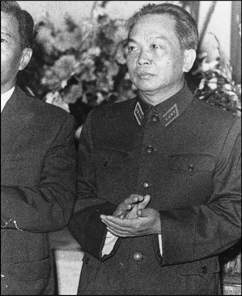
The two most famous military leaders in the Vietnam War were Gen. William C. Westmoreland of the U.S. Army, and Gen. Vo Nguyen Giap of North Vietnam. In the history of warfare it would be difficult to find two opponents who were so different. The only things they had in common were that they both were well educated and were passionately committed to the service of their countries.

Vo Nguyen Giap, defense minister of North Vietnam and its top general.
Westmoreland had ancestors who fought in the American Revolution and the American Civil War. A graduate of the U.S. Military Academy at West Point and a decorated veteran of both World War II and the Korean War, Westmoreland assumed command of the ground forces in Vietnam with the confidence of a man who had successfully waged war. He regarded his post at MACV, which he took command of in 1964 at the age of sixty, as the high point of his military career. He was determined to quickly win the war.
Giap was a high school history teacher who was self-taught in the art of war. As a teacher Giap gained a reputation as a lecturer of military history. He was appointed the commanding general of the Viet Minh troops in 1945 at the age of thirty-four and became their foremost military commander during the war with the French in the early 1950s. His crowning achievement was his decisive victory over the French at Dien Bien Phu in 1954. Giap was made the commander in chief of the North Vietnamese Army and later became minister of defense in the North Vietnamese government.
Giap joined the Communist Party in 1937. In 1939 the French government outlawed the Communist Party in France and its colonies, forcing members to either flee to other countries or go into hiding. Giap went into exile in China. But his wife, baby daughter, and his wife’s sister were captured by the French security forces in Vietnam and thrown into prison. There, Giap’s sister-in-law was guillotined, and his wife was later beaten to death by the guards. Giap’s daughter also died in prison, the cause of which is unknown. Their deaths reaffirmed Giap’s commitment to fight for an independent Vietnam.
When American combat troops arrived in 1965, Giap used the same tactics he had perfected against the French. Unfortunately for him the Americans were more powerful, and Giap’s efforts never achieved the same military success on the battlefield.